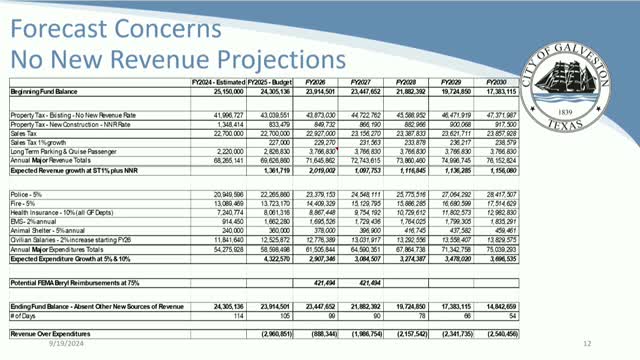City faces budget crisis as revenue growth stalls
September 19, 2024 | Galveston , Galveston County, Texas
This article was created by AI summarizing key points discussed. AI makes mistakes, so for full details and context, please refer to the video of the full meeting. Please report any errors so we can fix them. Report an error »

During a recent government meeting, officials discussed the city's financial outlook over the next five years, emphasizing the challenges posed by stagnant revenue growth against rising expenditures. The presentation outlined a model projecting no new revenue, which would maintain current property tax rates while anticipating a modest 1% annual increase in sales tax.
Key revenue sources were highlighted, including property taxes from existing and new construction, with projections indicating a slight increase in revenue due to anticipated developments, particularly from the opening of new cruise terminals in late 2025. However, officials cautioned that this revenue source is expected to plateau after an initial spike.
Expenditure forecasts revealed significant growth in costs, particularly in public safety and health insurance, with police and fire services projected to increase by 5% annually. This disparity between revenue growth and expenditure increases raises concerns about the city's financial sustainability, with projections indicating a potential drawdown of the fund balance below the charter-mandated 90 days by fiscal year 2028.
The discussion also touched on the implications of recent emergency management decisions, particularly the disbanding of emergency orders, which could limit access to federal reimbursement funds for storm-related expenses. Officials expressed uncertainty about the timing of these decisions and their potential impact on future funding.
The meeting concluded with a call for careful consideration of the city's financial strategies, particularly regarding new construction projects and their anticipated revenue contributions. Officials acknowledged the inherent risks in relying on historical trends for projections, urging a balanced approach to budgeting that accounts for both current realities and future opportunities.
Key revenue sources were highlighted, including property taxes from existing and new construction, with projections indicating a slight increase in revenue due to anticipated developments, particularly from the opening of new cruise terminals in late 2025. However, officials cautioned that this revenue source is expected to plateau after an initial spike.
Expenditure forecasts revealed significant growth in costs, particularly in public safety and health insurance, with police and fire services projected to increase by 5% annually. This disparity between revenue growth and expenditure increases raises concerns about the city's financial sustainability, with projections indicating a potential drawdown of the fund balance below the charter-mandated 90 days by fiscal year 2028.
The discussion also touched on the implications of recent emergency management decisions, particularly the disbanding of emergency orders, which could limit access to federal reimbursement funds for storm-related expenses. Officials expressed uncertainty about the timing of these decisions and their potential impact on future funding.
The meeting concluded with a call for careful consideration of the city's financial strategies, particularly regarding new construction projects and their anticipated revenue contributions. Officials acknowledged the inherent risks in relying on historical trends for projections, urging a balanced approach to budgeting that accounts for both current realities and future opportunities.
View full meeting
This article is based on a recent meeting—watch the full video and explore the complete transcript for deeper insights into the discussion.
View full meeting
